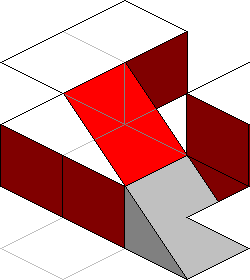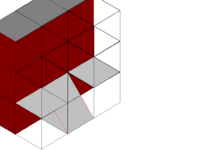- v50 information can now be added to pages in the main namespace. v0.47 information can still be found in the DF2014 namespace. See here for more details on the new versioning policy.
- Use this page to report any issues related to the migration.
Difference between revisions of "40d:Ramp"
m |
|||
| Line 107: | Line 107: | ||
== Ramps Versus Stairways == | == Ramps Versus Stairways == | ||
| − | Ramps have important limitations<sup>[ | + | Ramps have important limitations<sup>[name them!]</sup>, but they also allow slightly faster movement than stairways. For example, if a dwarf wants to go down and to the north using a stairway, it will have to take two steps: one step down a stairway and one step to the north. Going to the same place using a ramp only requires 1 step. Thus ramps are good for underground entrances to your fortress, even if they aren't going to be used by wagons. |
== Ramps Versus Channeling == | == Ramps Versus Channeling == | ||
Revision as of 13:11, 26 May 2009
A ramp is a map feature that allows dwarves and caravans to move between levels. Unlike a stair, ramps have no 'top', they only have a bottom. Ramps are the only way that wagons can move between levels in order to access your trade depot. A natural ramp is called a slope.
Using ramps
- The tile above a ramp must be open space for it to operate (it will appear on screen as a down triangle).
- The ramp must have at least one wall adjacent to it for it to operate. It seems that any adjacent ramps are considered part of the same, larger ramp for this purpose; for example, the following is allowed even though the ramp tile in the centre is not next to any wall:
█
|
.
|
.
|
.
|
█
|
█
|
▲
|
▲
|
▲
|
█
|
█
|
▼
|
▼
|
▼
|
█
|
- The tile above the wall must be non-solid e.g. a floor, stair, 2nd ramp, etc. (Not a wall, statue, floodgate, etc.). Whatever it is, it will be destroyed when a ramp is dug out under it.
A creature can then move from the square the ramp is on to the square above it.
In the picture, you can see the difference: because the upper ramp is adjacent on all sides to empty space, it cannot be used to reach the tile to the west
- Note: It can be used to reach the tiles to the northwest or northeast of the ramp (not shown in picture). Also, if the tile to the west had a natural rock wall on top of it, it can be mined from the ramp. v0.28.181.40d
If the upper right of the picture to the left is north, it would appear in DF like this (viewing top to bottom moving from left to right):
.
|
█
|
.
|
.
|
█
|
.
|
█
|
█
|
█
|
█
|
█
|
█
| ||
.
|
▼
|
█
|
█
|
█
|
▲
|
▼
|
.
|
█
|
█
|
▲
|
.
| ||
█
|
█
|
█
|
█
|
█
|
█
|
█
|
█
|
.
|
.
|
.
|
.
|
The other picture also represents a ramp that will not work as expected: Dwarfs on the second floor will be able to descend to the first, by walking onto the ramp and then off of the ramp, but dwarfs from the lower floor will not be able to go up.
Construction and Materials
There are two ways for your dwarves to create ramps. The first is to carve them into the earth itself (see digging), using the ground below or walls of stone, dirt, etc.. The second is to build a ramp out of materials such as stone, wood or blocks or bars.
- Digging a ramp uses the material and colour of the designated tile.
- Constructing a ramp uses the colour of the material used.
To build a ramp, which goes downward on the flat surface (for example, ground level ramp which goes into earth), you need to go one level below and designate an upward ramp from that level.
Collapse
Be sure to avoid mining out all of the floor tiles surrounding a ramp or staircase above and below it. If you do this, not only will the structures themselves be useless, they'll collapse, both of which can leave your dwarves trapped.
Also be extremely careful with digging ramps into areas that have trees growing on them. If you dig a ramp under a tile with a tree on it there will be a collapse that can easily kill the dwarf doing the digging and even injure or kill other dwarves in the immediate area. There is no risk in digging under boulders, shrubs or saplings.
Removing Natural Ramps or Slopes
Natural ramps can be mined out via the designation menu using the Remove Up Stairs/Ramps selection (d -> z, using the ingame interface). Like the selection says, only upwards ramps can be removed in such a manner. Selecting a downwards ramp in such a manner has no effect. Removing the upward ramp will automatically remove the downward ramp on the level above. The downward part of a ramp doesn't really exist, a creature standing on a ramp tile will be on the lower tile until they move out of the tile.
Removing Constructed Ramps
Constructed ramps can be removed like any other construction via the designation menu using the Remove Construction selection (d -> n, using the ingame interface). Constructed ramps will leave one stone of the sort the ramp was constructed from.
Ramps Versus Stairways
Ramps have important limitations[name them!], but they also allow slightly faster movement than stairways. For example, if a dwarf wants to go down and to the north using a stairway, it will have to take two steps: one step down a stairway and one step to the north. Going to the same place using a ramp only requires 1 step. Thus ramps are good for underground entrances to your fortress, even if they aren't going to be used by wagons.
Ramps Versus Channeling
Ramps are better suited to carving rooms spanning multiple z-levels than channels. They are safer, because your miners will not channel the stone from underneath each other and will not get stranded on a single rocky outcrop because they could not channel out the tile they're standing on.
For example, to build a dining room three z-levels high, carve a single ramp on the first (bottommost) floor, another ramp on the second floor next to it and designate the whole third (topmost) floor for digging. After that, designate the second floor to be filled with ramps, then to be cleared of them (you might need to channel out the floor above the downward ramp). Repeat on the first floor. Voila, you have a large dining room your dwarves won't appreciate.
Digging an execution pit is even simpler. Start carving ramps from the very top, and you'll need to remove them only on the bottommost floor.
| Rooms | |
|---|---|
| Furniture |
Animal trap • Anvil • Armor stand • Bed • Bin • Bucket • Cabinet • Cage • Coffin • Container • Restraint • Seat • Statue • Table • Weapon rack |
| Access | |
| Constructions | |
| Machine & Trap parts |
Axle • Gear assembly • Millstone • Screw pump • Water wheel • Windmill • Lever • Pressure plate • Trap • Support |
| Other Buildings | |
| Related Articles | |

